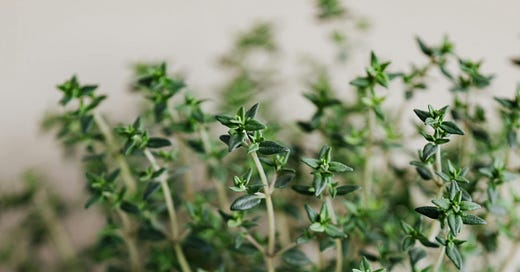The Easiest Herb to Grow
Why you need thyme in your home
Introduction
Thyme is a versatile and aromatic herb that can be used in many dishes, from soups and stews to fish and poultry. It has a pleasant, pungent flavor and a fragrant aroma. Thyme also has health benefits, such as antibacterial, antifungal, and anti-inflammatory properties. There are many reasons why you need to have thyme in your backyard.
As an evergreen herb, thyme allows harvesting all year round. The leaves can be used either fresh or dried. Thyme can be sown from cuttings or seeds indoors. The herb thrives under warm climates and free-draining soil. Thyme grown from seed takes roughly one year to mature. Here are important considerations before sowing thyme:
1. Choose the Right Variety
There are over 300 varieties of thyme. In this post, we examine the four most common varieties. Choose a variety that can flourish under the climatic conditions in your region. Here are the most widespread varieties of thyme:
Common thyme (Thymus vulgaris)
Also known as garden or English thyme, it is the most widely used culinary thyme. It has a pungent flavor and a pale lilac color. It has small, gray-green leaves and pink or white flowers. It grows up to 12 inches tall and wide and can tolerate cold and drought.
Lemon thyme (Thymus x citriodorus)
This variety has a lemony scent and flavor. It has green or variegated leaves and pink or purple flowers. It grows up to 15 inches tall and wide, and prefers moist soil. The citrusy flavor and aroma go well with fish, chicken, and desserts.
Creeping thyme (Thymus serpyllum)
This variety is ideal for ground cover, as it forms a dense mat of tiny leaves and flowers. It has a mild flavor and can be used as a lawn substitute. It grows up to 3 inches tall and spreads up to 18 inches wide. It likes full sun and well-drained soil.
Caraway thyme
Caraway thyme has a distinctive caraway scent and taste that is traditionally used to flavor barons of beef. Thyme can be used fresh or dried, and it has many health benefits such as aiding digestion, soothing headaches, and acting as an antiseptic.
2. Plant Thyme in the Right Spot
Thyme is a Mediterranean herb that thrives in sunny, dry and poor soil conditions. It does not like wet or rich soil, as it can cause root rot or fungal diseases. To plant thyme in the ground, choose a spot that gets at least six hours of sun per day, and amend the soil with sand or gravel to improve drainage. You can also plant thyme in containers, using a well-drained potting mix with some grit added. Make sure the pots have drainage holes and raise them off the ground to prevent waterlogging.
3. Care for thyme plants
Thyme is a low-maintenance herb that does not need much watering or fertilizing. Water thyme plants only when the soil feels dry to the touch, and let it dry out completely between watering. Feed thyme plants once a year in spring with a balanced, organic fertilizer diluted to half-strength. Prune thyme plants after they flower to encourage new growth and prevent them from becoming woody. You can also divide thyme plants every three years to rejuvenate them.
Conclusion
You can harvest thyme leaves throughout the year, but they have the best flavor just before the plants flower. To harvest thyme, cut off the stems with scissors or garden shears, leaving about an inch of growth above the base of the plant. You can use fresh thyme leaves directly in your recipes, or dry them for later use. To dry thyme, tie the stems in small bundles and hang them upside down in a warm, airy place away from direct sunlight. When the leaves are dry, strip them off the stems and store them in an airtight container.




